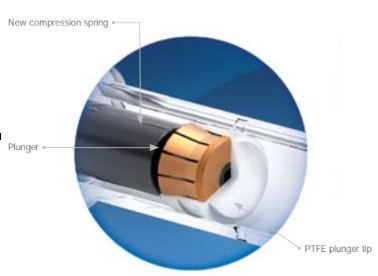HAMILTON HD-Type Syringe for Reproducible Headspace Gas Chromatography
HAMILTON SYRINGE SELECTION GUIDE

The reproducibility of headspace GC results has been an issue. Possible reasons why headspace GC analysis is prone to errors include: 1) exact sampling and dosing of gases is tedious. Unlike solids and liquids, gases have neither fixed volume nor shape and are molded completely by the container in which they are held. 2) Partition coefficients (e.g., ratio of the analyte equilibrium concentration in the gas phase volume and the liquid phase volume) of the analytes in the headspace are usually unknown.
It is especially important in routine analysis to evaluate the reproducibility of the sample volume. In terms of the value of the partition coefficient, it has been demonstrated that sample volume reproducibility is critical only for low partition coefficient values, whereas for higher values, the influence on the reproducibility of analytical results was negligible. The value of the partition coefficient is generally not known, however, and therefore it is always advisable to reproduce the sample volume in duplicate analyses. Reproducibility issues with headspace GC are also a reason why often internal standards are used for a quantitative analysis.
One source of error in headspace GC is the exact dosing of the sample volume into the injection system. The injection syringe plays the key role of delivering a sample volume as accurate and precise as possible. Conventional headspace syringes employ an O-ring sealed plunger carrying a PTFE tip which seals toward the internal surface of the syringe barrel. This design possesses limited adjustment properties to thermal changes because of different thermal expansion coefficients of the PTFE and rubber O-ring materials and a very long relaxation time of the rubber O-ring. Leakage of conventional headspace syringe plungers is common when the plunger experiences temperature changes. Hamilton’s HD-type syringe addresses this problem with a newly designed spring supported sealing. The metal spring compensates for the thermal expansion of the PTFE tip and exercises a constant temperature, independent contact force toward the glass surface. The sample plunger technology is also successfully used for the ITEX syringes.
The reproducibility of headspace GC analysis with the new HD syringe was tested with a standard mixture and multiple injections at different temperatures.
CONTACT US
Tel: +44 (0) 151 649 4000
Email: marketing@greyhoundchrom.com
FOLLOW US
YOU MAY ALSO BE INTERESTED IN OUR NEWSLETTER















